Lecture 5 - Long-Term memory: Systems and Processes
1/83
There's no tags or description
Looks like no tags are added yet.
Name | Mastery | Learn | Test | Matching | Spaced |
|---|
No study sessions yet.
84 Terms
What limiting factors have we not been able to describe for LTM?
the duration of LTM
there is no timeline for when your LTM expires and so after, say 2 years, the memories in LTM are automatically gone
the capacity of LTM
there is no point when your LTM is full and you will never be able to form LTM again—except with brain damage but that’s not due to your LTM being full
*this is different from STM, which do have those as limiting factors
How do we know that LTM lasts a long time?
Ebbinghaus Forgetting Curve
Ebbinghaus tested his LTM using tri-grams, which are a group of 3 letters which are not words. He practiced those tri-grams until he knew them all and then tested himself on them for over a month.
He found that after learning them all and immediately testing himself, his accuracy was 100%. But his accuracy dropped dramatically as time went on.
By 1 day his accuracy dropped by 2/3. After day 2, his accuracy/memory plateaued for the rest of the month.
Therefore, indicating that our LTM can last once it is encoded in our LTM.
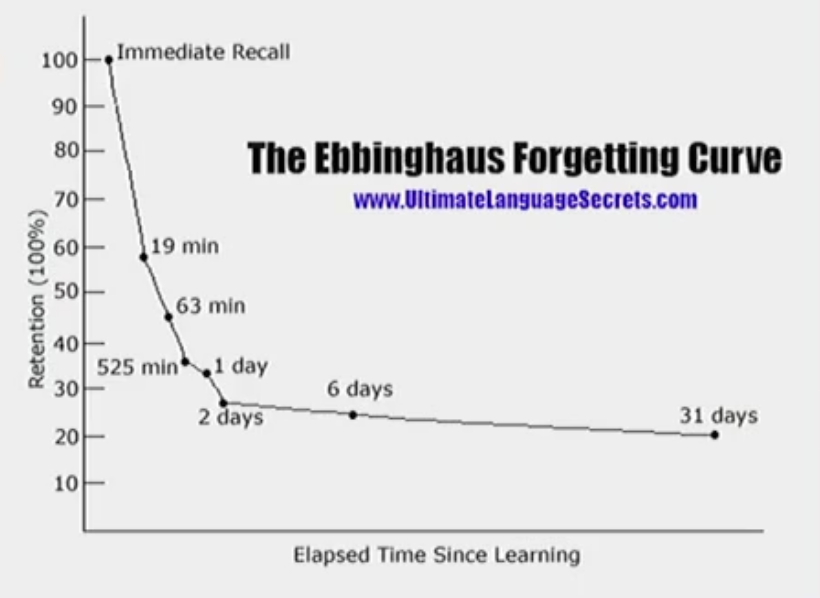
How is LTM stored?
Semantically (based on meaning).
What does remembering items from LTM depend on?
It depends on how the information was encoded and how we attempt to retrieve the information.
The more time and meaning we add to the incoming information, the easier it is for us to retrieve it.
*if organised on the way in, easier to retrieve later
What are the 2 approaches to explain how LTM works?
Systems Approach (different types of LTM systems)
Processing Approach (different processes for LTM)
Define the primacy effect.
Good memory for items presented at the beginning of the list.
Define the recency effect.
Good memory for items presented at the end of the list.
Why does the primacy effect occur?
This happens because, once we hear a list and try to remember it, we will repeat whatever we are hearing first and then continue to repeat what else is being said afterwards.
In doing this, the items at the beginning of the list will get repeated the most and so they will be encoded into LTM.
Hence, creating the primacy effect.
Why does the recency effect occur?
This happens when people repeat back the last items first because they are still active in our STM (since we just heard it) and so those items can easily get repeated.
Hence, creating the recency effect.
What does the observation of having a primacy or a recency effect show us?
It supports the idea that we have two separate memory systems; STM and LTM, because there are things that affect the primacy effect but not the recency effect, and vice versa.
Would adding a delay between the time the words were said, with when we have to repeat the memory, affect the primacy or recency effect? Why?
It would affect the recency effect because those things are likely less active in STM due to the delay.
Hence, we can’t remember it as well.
How do we decrease the primacy effect? Why?
Researcher must increase the rate of the items being presented (ie. instead of 2 items presented at once, now 4 items are presented at once).
This then reduces the amount of time we have to rehearse each item, which limits encoding to LTM. Thus, affecting how well we can remember the first thing said (which was the farthest away from being active in our STM since it was said first).
What about the items in the middle of the list? To what extent are they rehearsed?
It does not get rehearsed as much because as the list goes on it becomes very difficult keep track of everything being said and also memorise it.
So we don’t really remember what is said in the middle.
What theories can explain our poor memory for things in the middle of the list?
Decay theory (explained in FC above)
Interference theory
What are the 2 types of interference?
Retroactive interference (RI)
Proactive interference (PI)
Define retroactive interference.
When new information interferes with our ability to retrieve old information.
Define proactive interference.
When old information interferes with our ability to code and retrieve new information.
Define semantic memory.
All the stuff you know but you don’t remember how you know.
What’s an example of semantic memory?
Let’s say a few years from now you remember the definition of semantic and episodic memory but you cannot remember where you learned those definitions from.
Define episodic memory.
A type of long-term memory that involves the conscious recollection of previous experiences together with their context in terms of time, place, emotions etc…
Who created one of the most influential memory systems frameworks?
Squire.
Explain Squire’s memory system framework.
Squire explained that there are 2 systems within LTM:
Declarative (explicit)
Non-declarative (implicit)
Within those separate systems there are many branches that influence our memory.
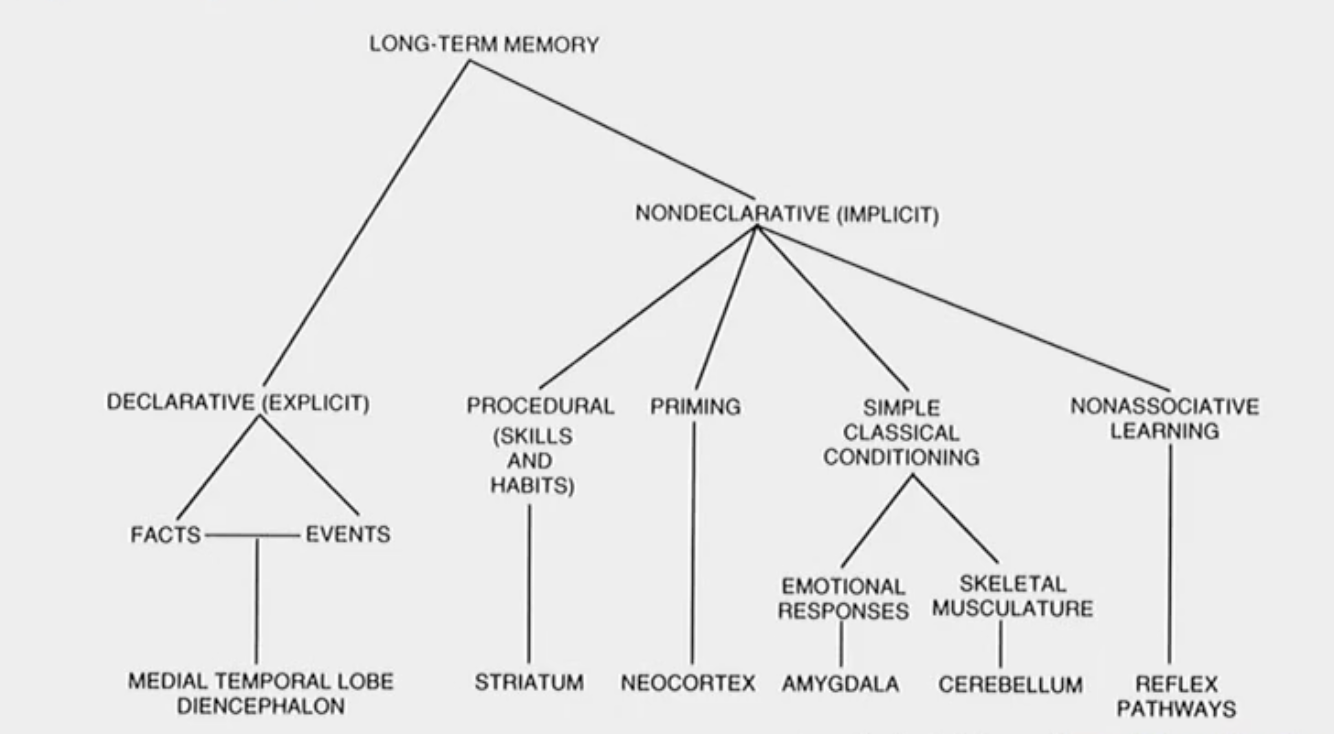
Explain declarative (explicit) LTM.
Declarative (explicit) LTM are full of memories that we can make conscious. Hence, we are not conscious of the things in declarative memory all the time but we can make them conscious.
For instance, we can talk about facts and events when needed (but that doesn’t mean those things are on our minds 24/7). Those are semantic and episodic memories, respectively.
Explain non-declarative (implicit) LTM.
Non-declarative (implicit) LTM are full of unconscious memories that influence our behaviour.
Within it are:
procedural skills and habits
priming
simple classical conditioning
non-associative learning
Define priming.
When the presentation of 1 stimulus makes it easier/faster to process information afterwards (stimulus #2).
Define non-associative learning.
Things you learn simply that don’t require a connection between a stimulus and response.
ie. to be able to ignore the sensation of your butt on the chair when it’s not relevant to pay attention to
What are the different memory tasks for explicit LTM?
recognition task
recall task
free recall
serial recall
cued recall
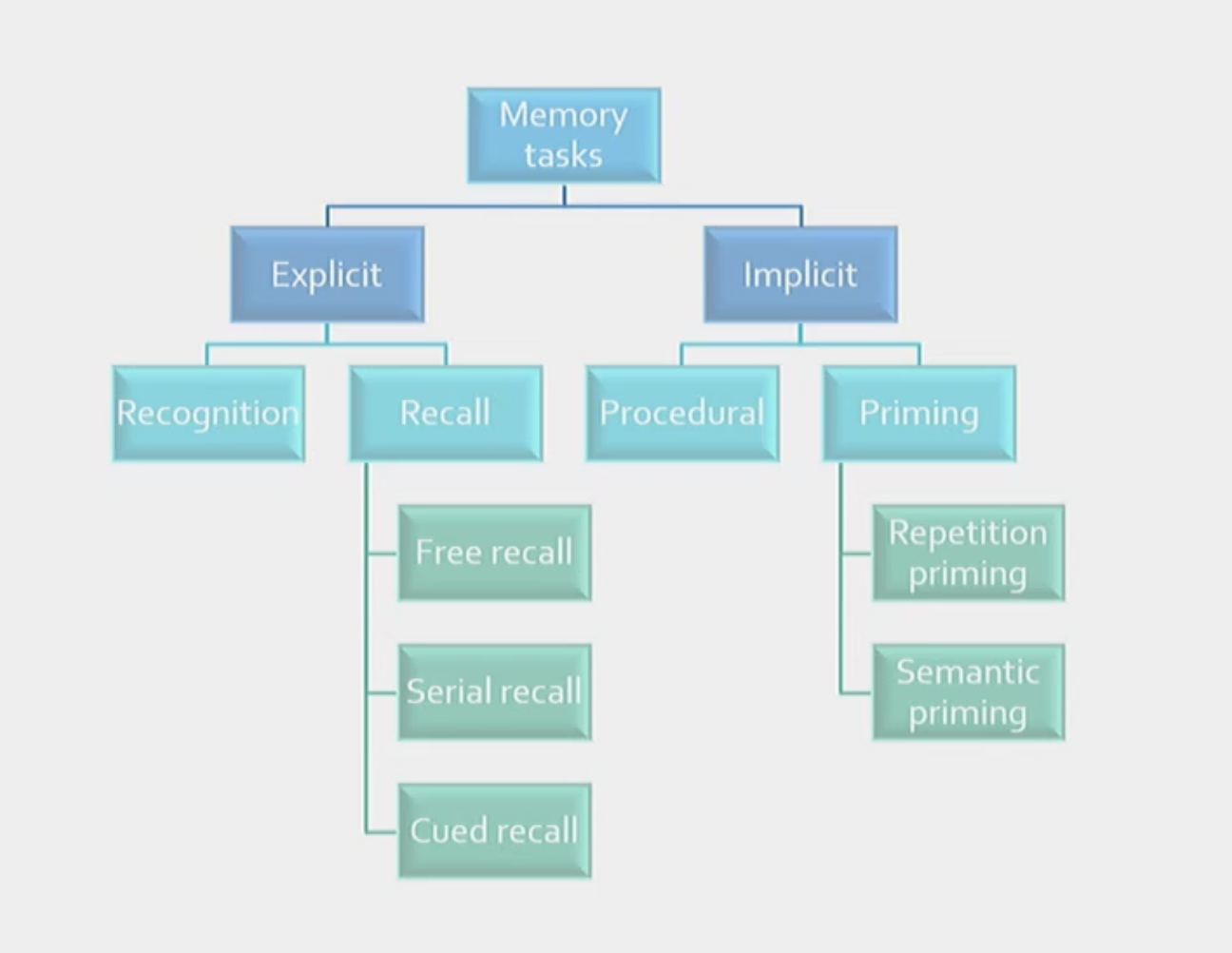
Define a free recall task.
When you have to recall items in any order.
Define a serial recall task.
When you have to recall the items in the order they were presented.
Define a cued recall task.
When you have to recall something based on a hint you were given.
ie. one of the words you learn from a list is bat and you are given a hint that the word rhymes with ‘cat,’ which then helps your memory.
What are the different memory tasks for implicit LTM?
Procedural task
Priming task
repetition priming
semantic priming
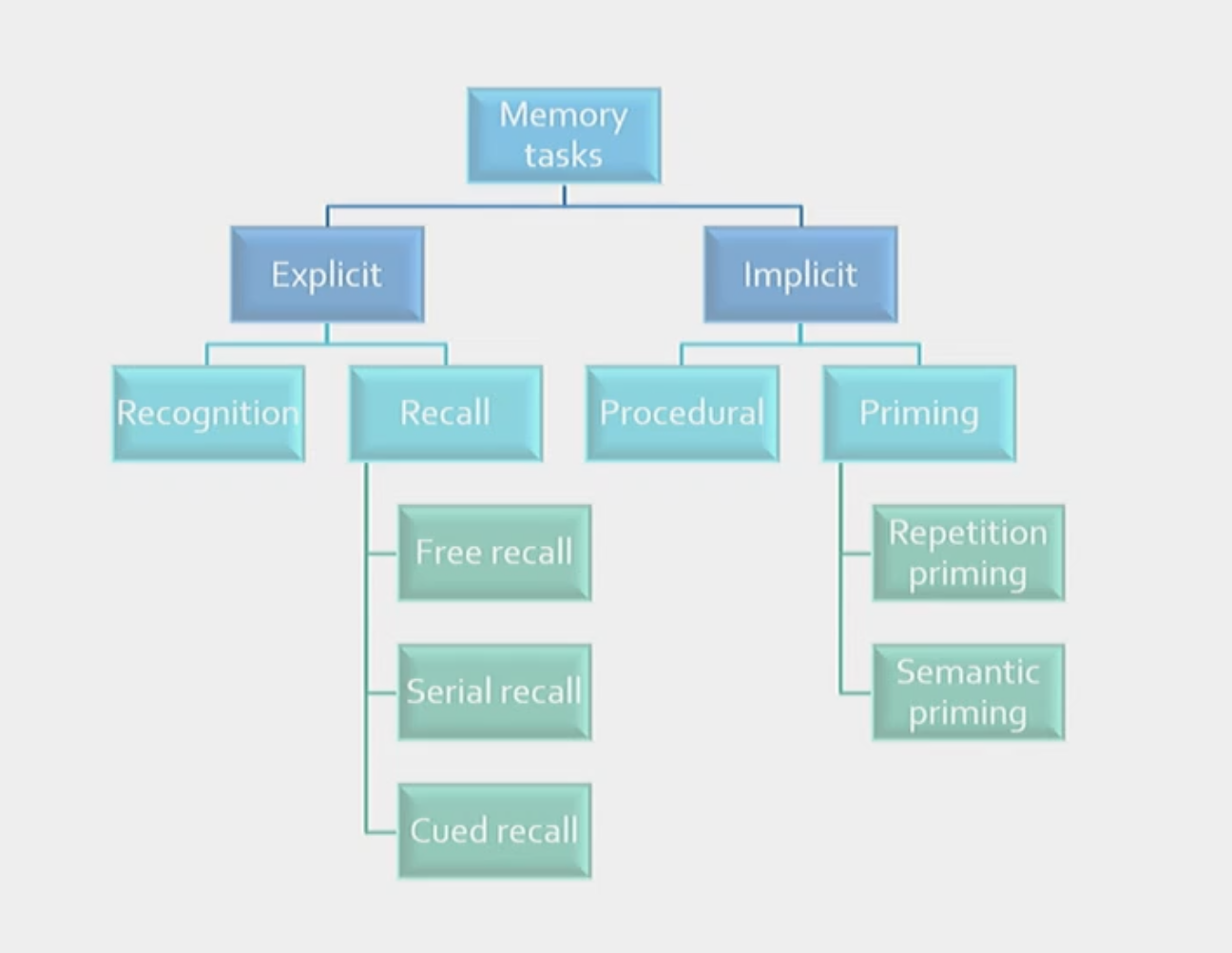
What is a procedural task?
When you ask participants to do something and you observe to see if they’ve improved over time.
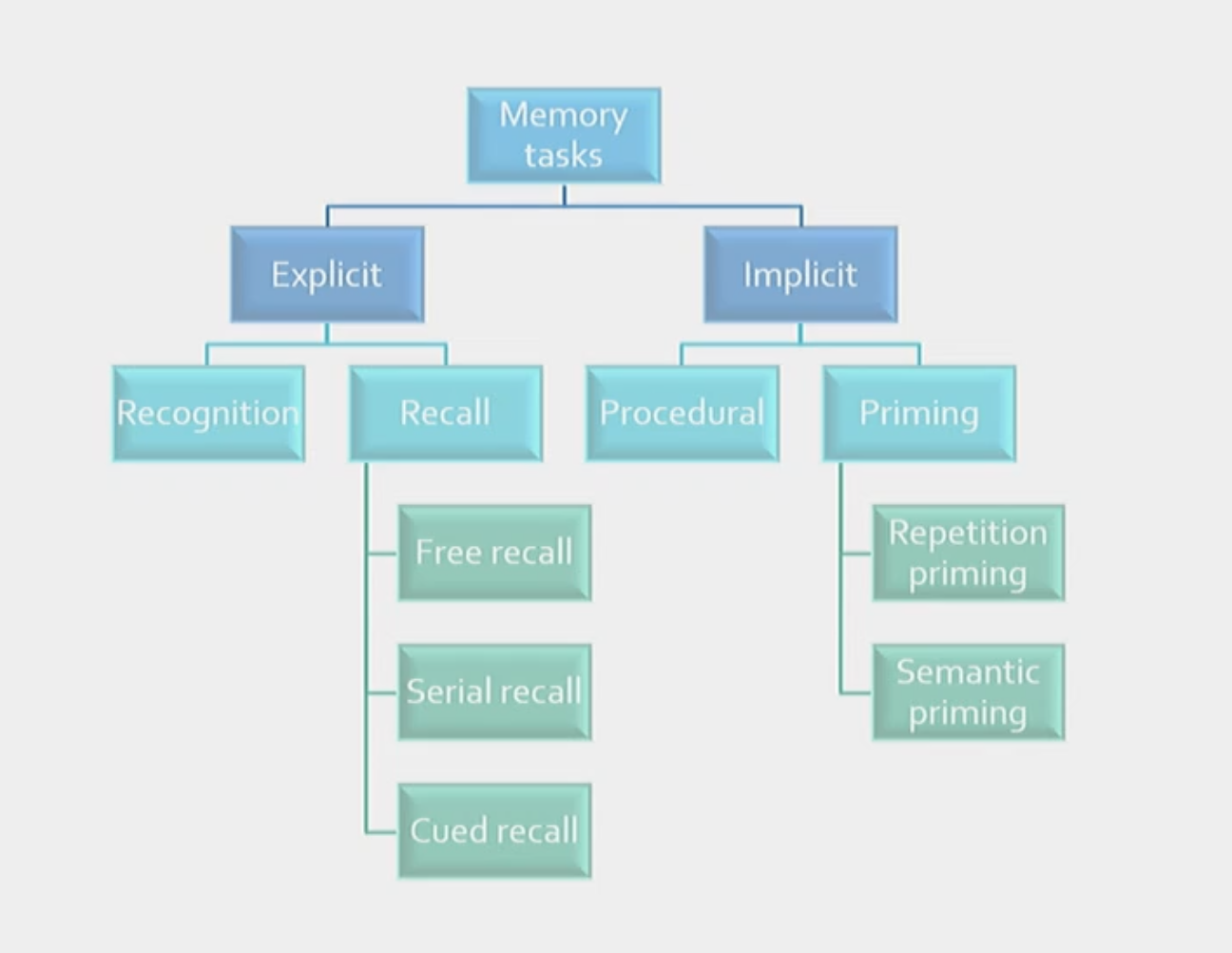
Define repetition priming.
When you present the exact same stimulus twice and you see performance improve after showing the stimulus a second time.
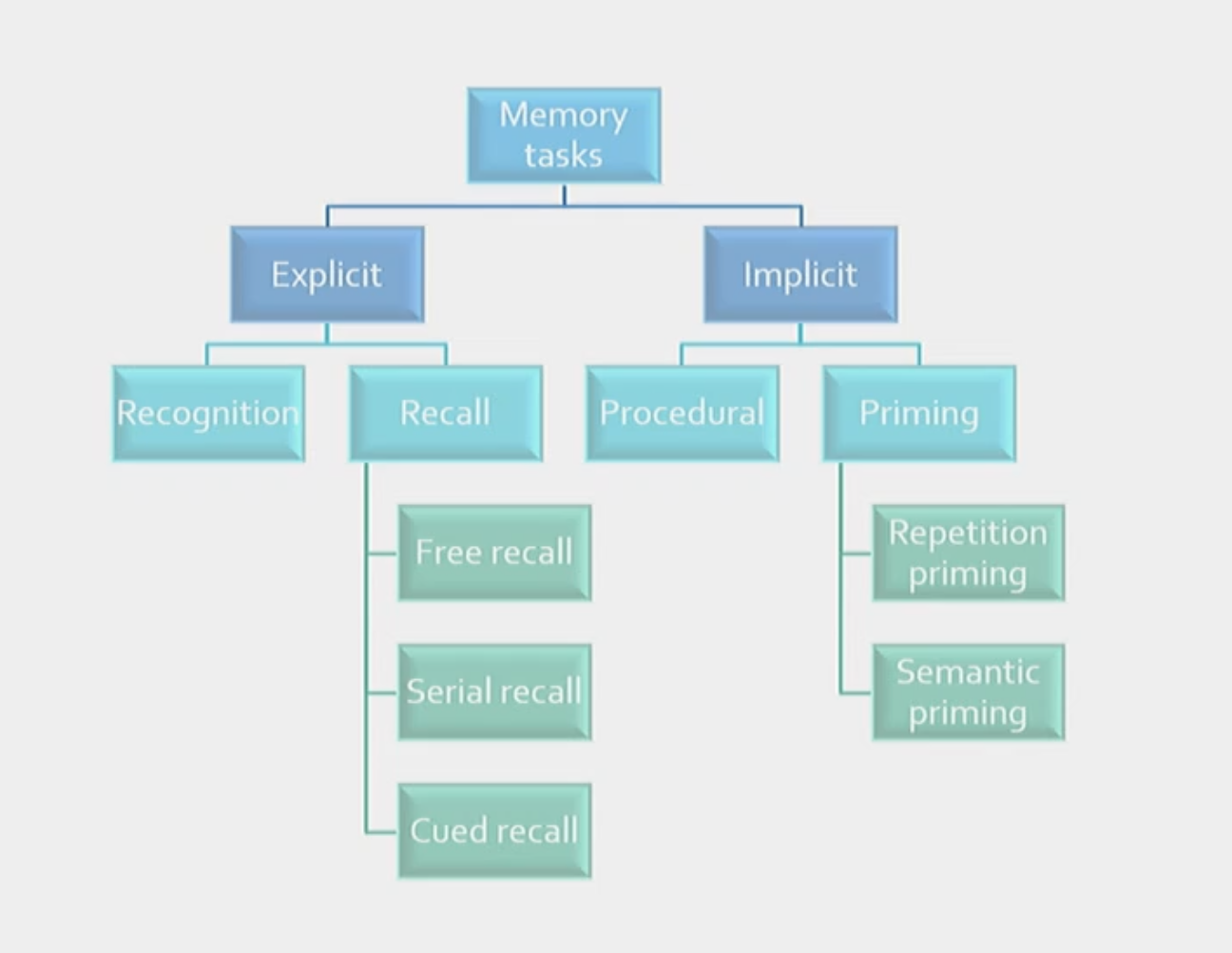
What is an example of repetition priming?
Seeing the word "table" and then, later, being shown a scrambled version of that same word, but you could recognise it very quickly.
Because you’ve been primed with the word so its active in your mind and easy to think about now.
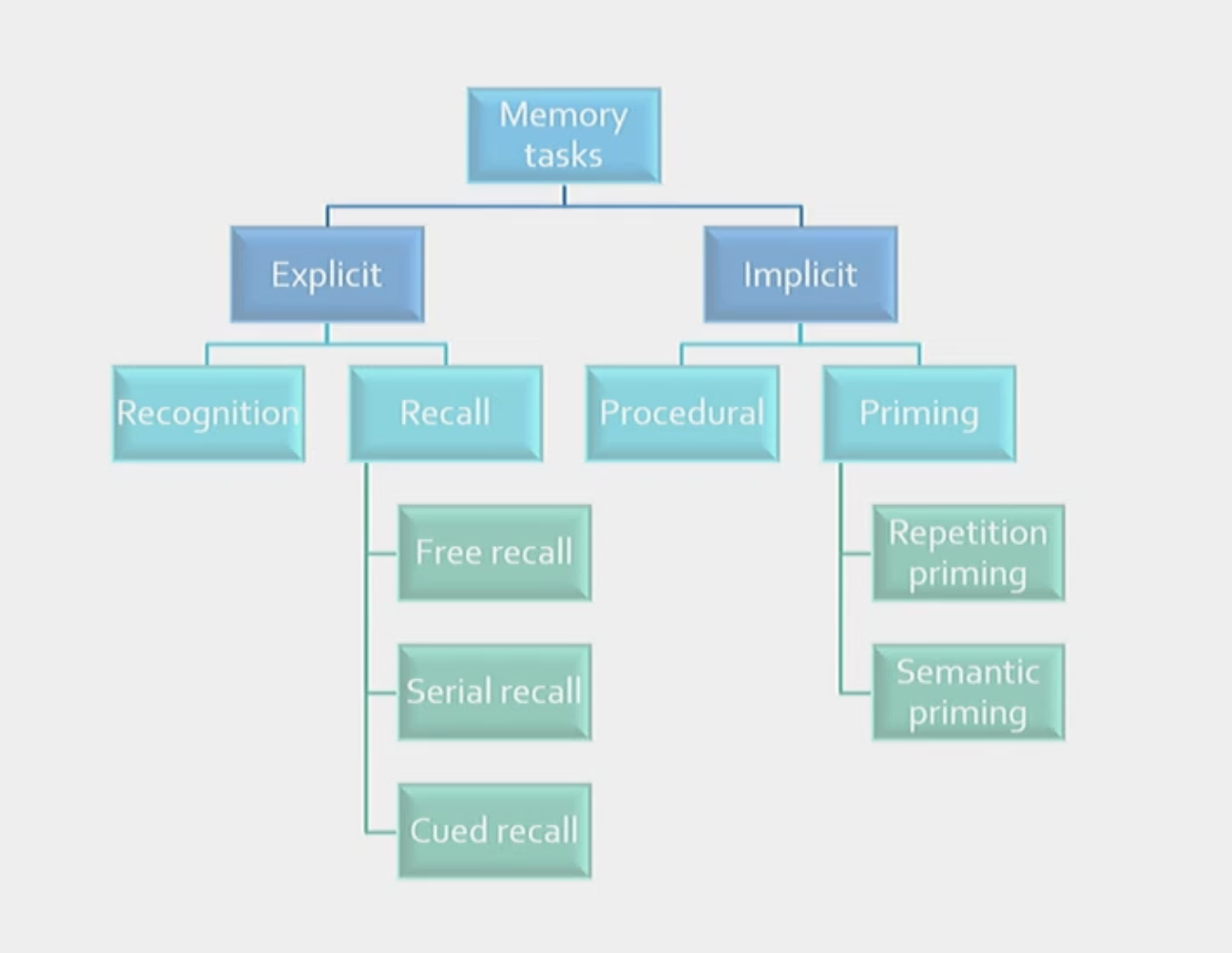
Define semantic priming.
When an item presented to you is semantically related to the next stimulus and so your performance increases because you were just primed with something very similar.
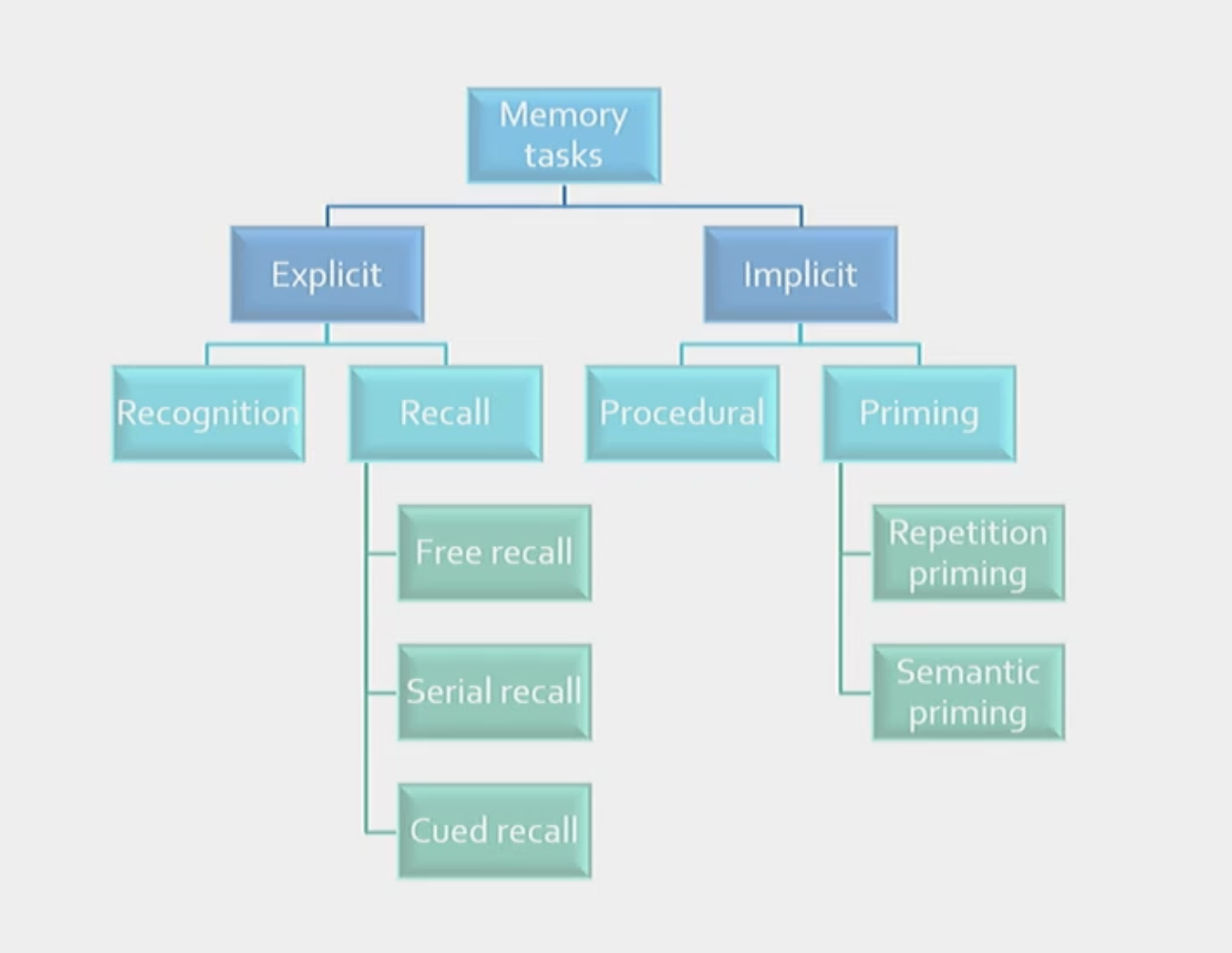
Define retrograde amnesia.
Memory loss for events that occurred before the trauma.
How does brain damage affect the severity of retrograde amnesia?
The worse the brain damage the greater the memory loss.
Which memories are most easy to recover when dealing with retrograde amnesia?
Your oldest memories are recovered first but then the memories leading up to the accident are usually the hardest to recover.
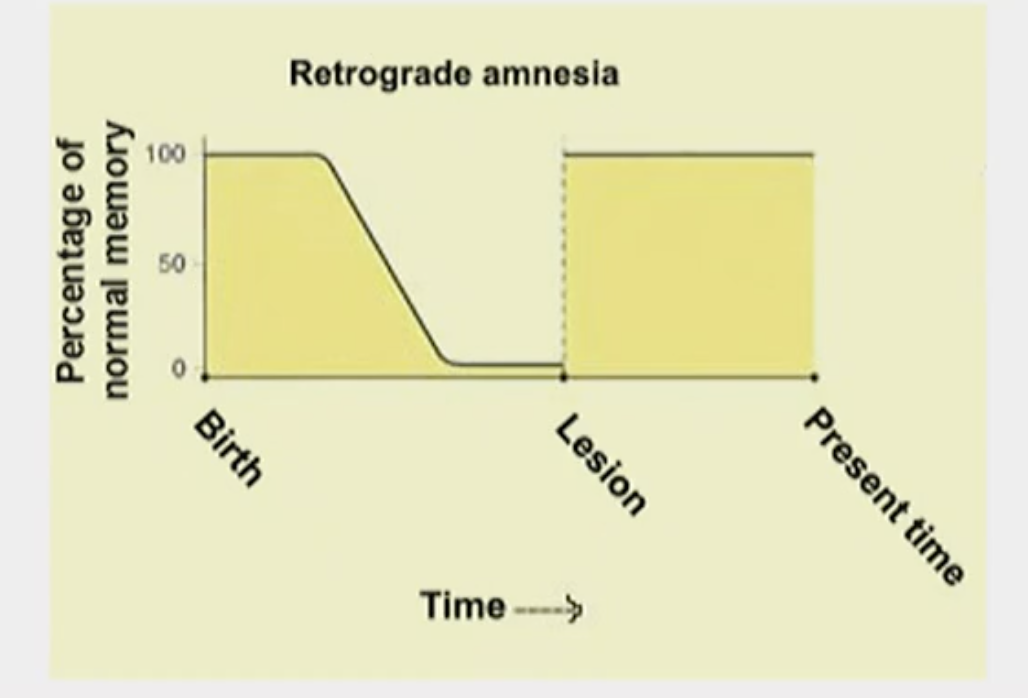
Define anterograde amnesia.
The inability to form new memories after the trauma.
Can people with anterograde amnesia recover?
No, because the neurons died and will not re-generate.
Who is a common patient that we talk about when discussing Amnesia? What happened to this patient?
Patient H.M
His seizures started at 10 years old and they kept getting more severe to the point where, at 27, he couldn’t work since they were becoming intractable.
Hence, his doctors decided that since the seizures were starting from the Medial Temporal Lobe, they should remove it completely and that should stop his seizures.
His seizures stopped but he lost his ability to consolidate memories—he got anterograde amnesia from it.
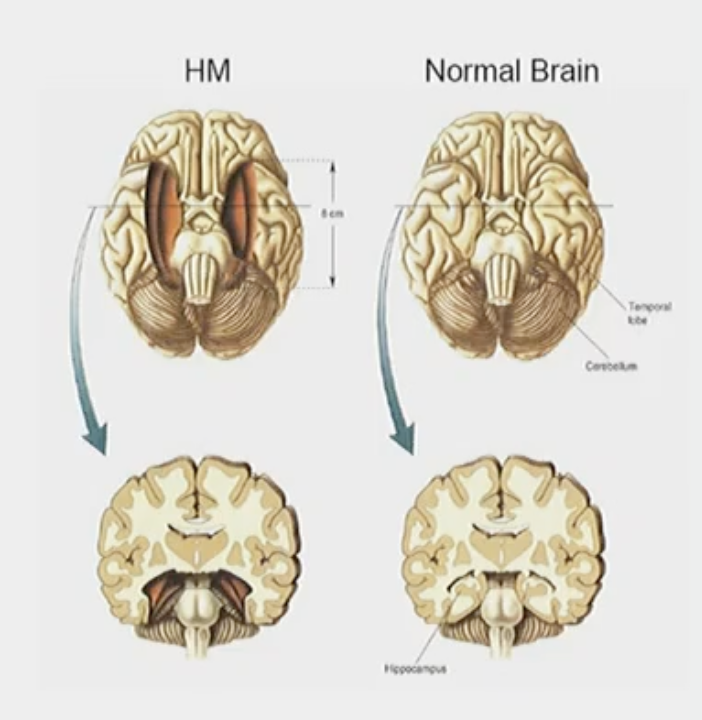
Define intractable.
Hard to control/deal with.
Define memory consolidation.
the ability to form new memories.
What type of memories was H.M able to form after the surgery?
He lost all his ability to form explicit memories but could still acquire implicit memories.
ie. he could still learn tasks
What is an example of patient H.M forming an implicit memory?
He was taught how to mirror trace and would practice a lot. However, due to his anterograde amnesia he could not remember learning the skill and so when he tried it he would think that he’s just naturally gifted at it—when really he’s been practicing.
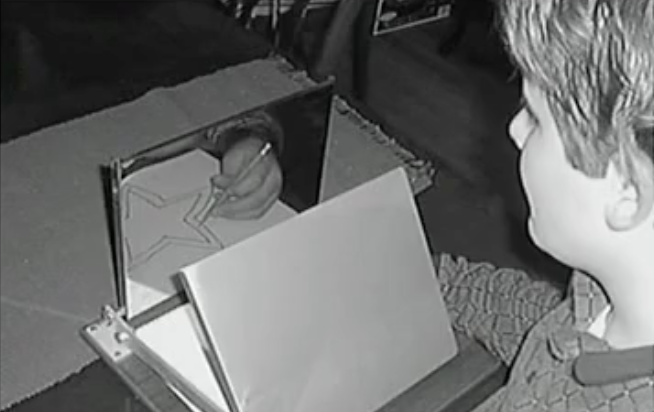
What are 3 types of memory consolidation?
Synaptic consolidation
Systems consolidation
Reconsolidation
Define synaptic consolidation.
This process occurs at the neuronal level and is fast-acting—it is what directly happens between adjacent neurons when forming LTM.
*this occurs at the neuronal level and fast.
Define systems consolidation.
A gradual process where memories stored in the hippocampus become reorganised and transferred for LTM, allowing us to form episodic and semantic memories.
*it involves multiple brain structures and can take decades.
Define reconsolidation.
It is when our memory is reactivated and is temporarily vulnerable to change, and then needing to be consolidated again to become stable.
Define long-term potentiation.
The mechanism for synaptic consolidation.
Which area of the brain is important for systems consolidation?
Medial temporal lobe (the hippocampus is in there).
What is memory consolidation dependent on?
Hippocampus.
Is retrieval of memories dependent on the hippocampus according to the standard model?
No, it is not dependent.
Explain the standard model for memory consolidation.
Standard Model
Both semantic and episodic memory are stored in the cortex with many different neurons. The hippocampus (the triangle) then supports the activation of the neurons inside the cortex while they form cortical connections. Once they form cortical connections, the memory is made. Hence, why memory consolidation needs the hippocampus.
When the connections have been made, the the hippocampus is not needed anymore (that’s why we don’t need the hippocampus for retrieval).
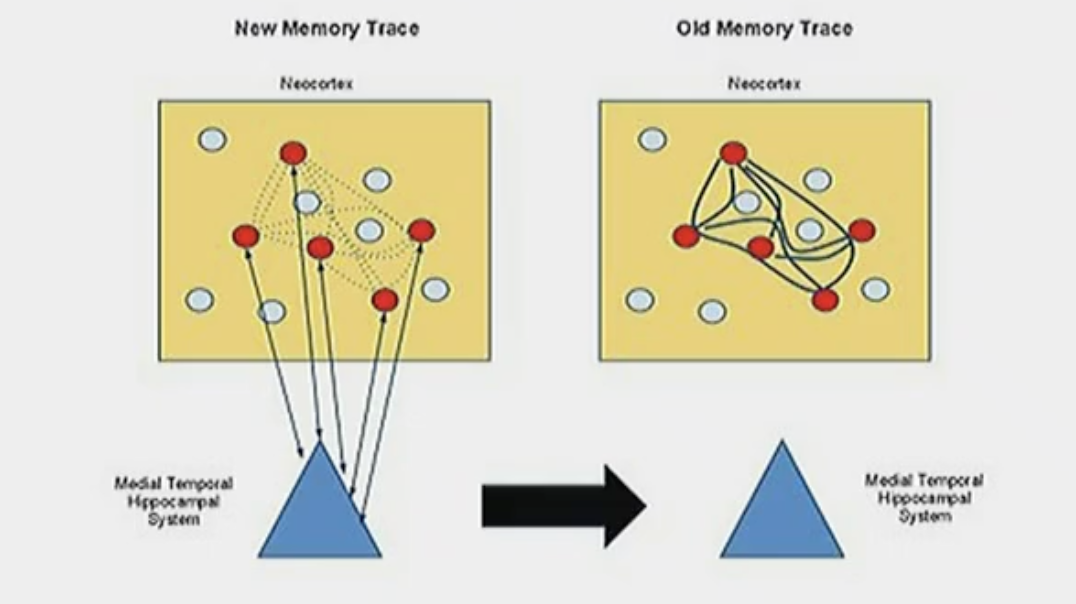
Explain multiple trace theory (MTT) for memory consolidation.
It is an alternate model to the standard model.
It suggests that memory consolidation is dependent on the hippocampus and that retrieval is not dependent on the hippocampus, but only for semantic memories.
Hence, for episodic memories, memory consolidation and retrieval both need the hippocampus.
How does data support multiple trace theory?
In patient H.M they found that he was able to retrieve past memories from before the trauma but that all of them were semantic in nature—he could not retrieve episodic memories.
This is because, the medial temporal lobe was removed, which is where the the hippocampus is located.
Therefore, there is evidence to suggest that the hippocampus is needed for both coding and retrieval.
Define the levels of processing theory.
Craik and Lockhart (processing theory)
Memory is a by-product of the level at which information is processed at encoding.
Hence, the deeper the processing at encoding, the better memory we have overall.
What are the 2 types of rehearsal?
Maintenance rehearsal
Elaborative rehearsal
Define maintenance rehearsal.
When we repeat things to keep them active in our STM or transfer things into our LTM.
Define elaborative rehearsal.
Links meaning to things in our STM to things in our LTM so that it is easier for us to remember things (bc transferring is not efficient—so we use elaborative rehearsal).
Define incidental memory test.
A surprise memory test.
Explain Craik and Lockharts experiment.
They asked participants 3 questions, each with two different words written underneath:
Are the words written in the same type of font?
Do these words rhyme?
Do the words have a similar meaning?
After answering the questions, the participants had to recall what the words were, but they were not informed that they had to memorise the words beforehand—incidental memory test.
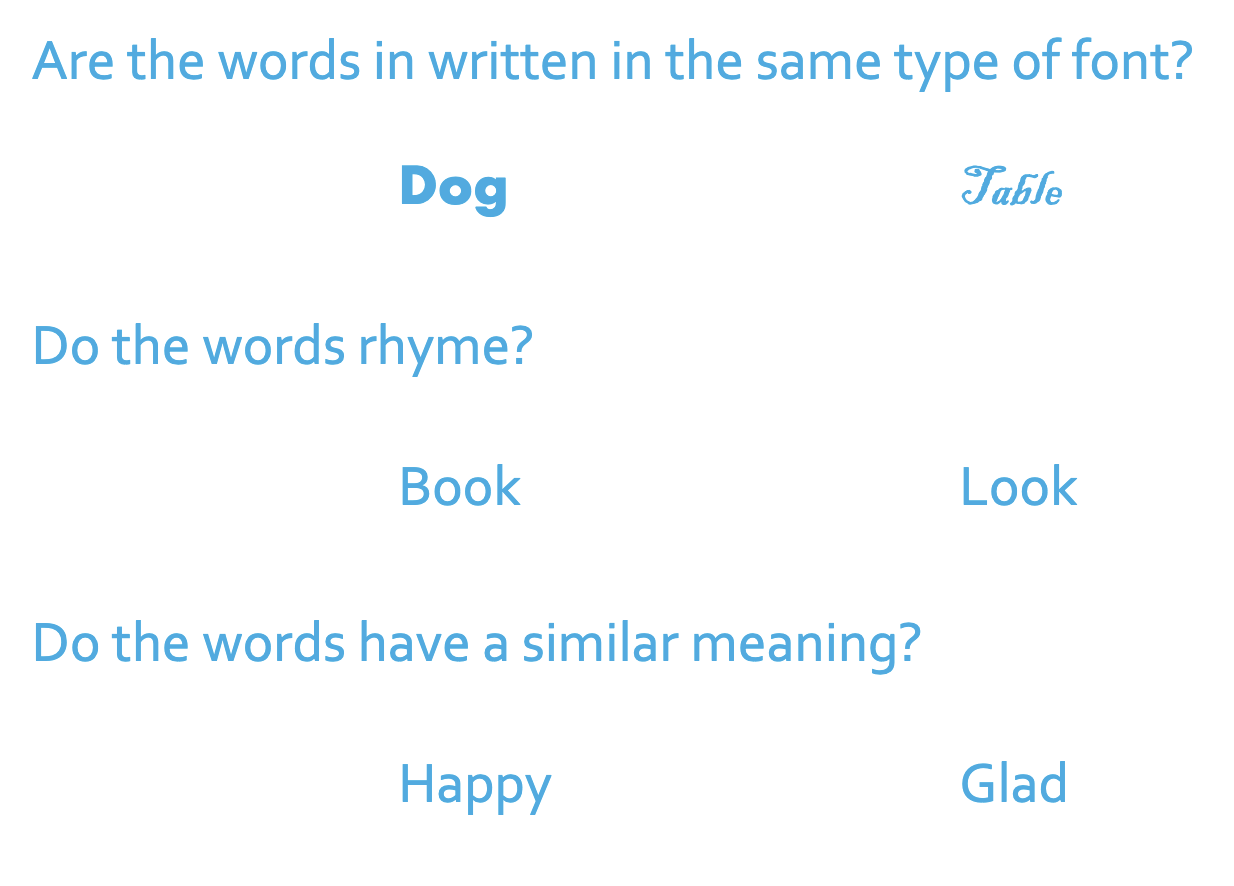
What were the results of Craik and Lockharts experiment?
For question 1 they noticed that the participants didn’t have to read the words in order to figure out if the words were the same or different font. Hence, not much thinking was required and the % of recall was lowest for those words.
For question 2 they noticed that participants had to convert what they were reading (visual) into a phonological code to know if they rhymed or not. Hence, putting the code in twice (audio and visual) so % of recall was in the middle.
Lastly, for question 3 they noticed that participants not only had to convert what they were reading (visual) into a phonological code (due to the articulatory rehearsal process), but also had to attribute meaning to each word to know if they had similar meaning. Thus, they had the memory coded twice (audio and visual) but also enacted in elaborative rehearsal. Hence, % of recall was the highest for those words.
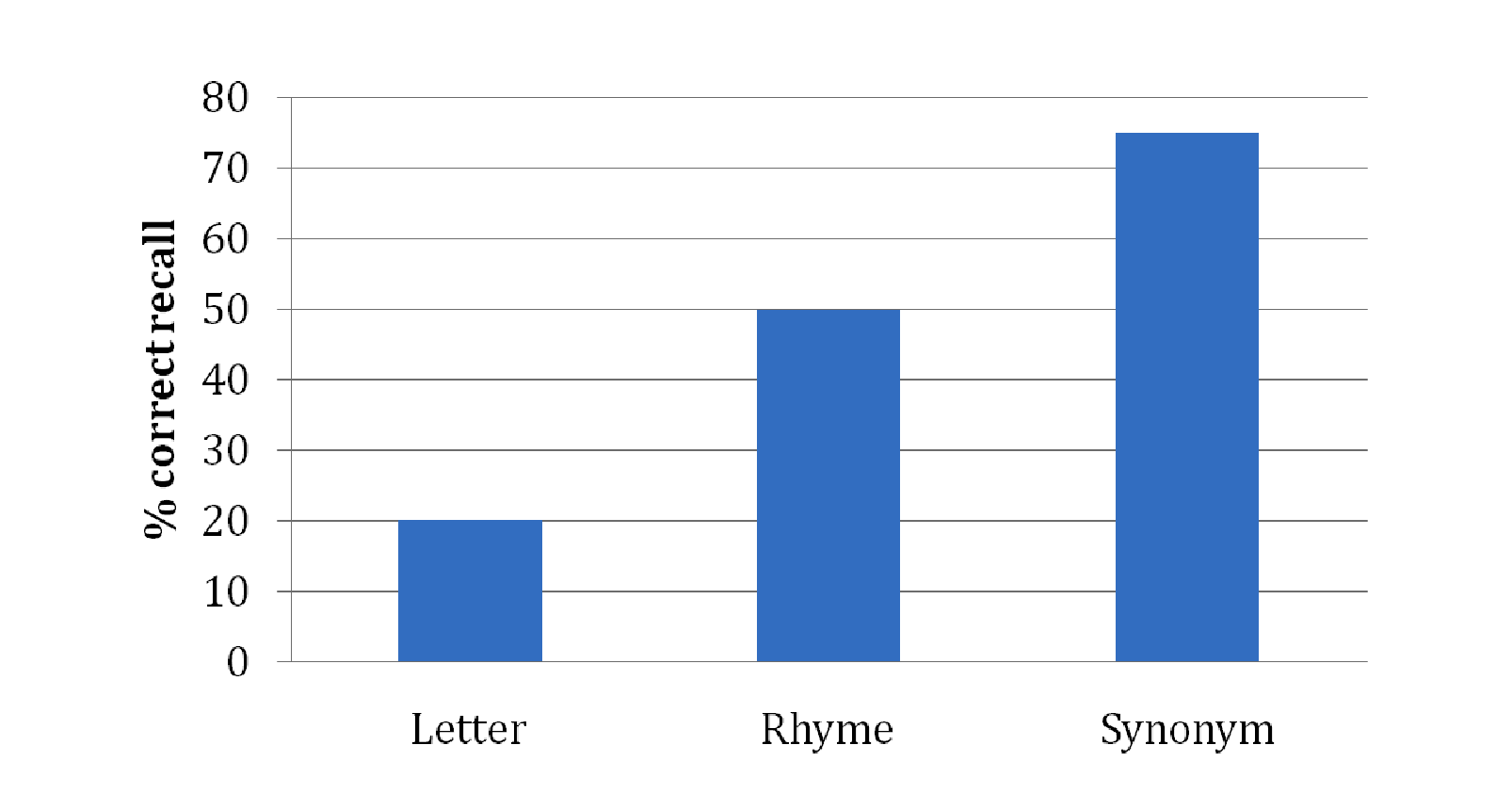
What are the limitations about Craik and Lockharts level of processing theory definition?
In the definition of their theory they mention ‘level’ of processing information. However, what is considered ‘deep processing?’
There is no concrete definition.
Why does ‘deep processing’ not have a definition?
This is because according to the theory, deep processing leads to better memory. So by that vein, anything that leads to better memory should be considered ‘deep processing.’
This is obviously not true as what if I said I remember better when I eat potato chips. Is eating potato chips really a sign of deep processing—no.
Hence, it is a very circular definition that does not work because there are no specific boundaries that dictate what is and is not deep processing.
Define isolation effect (aka von Restorff effect or distinctiveness effect).
It is the idea that the more distinct something is the more we will remember it.
Why does the isolation effect occur?
the distinctiveness of the thing makes it stand out from all our other memories in LTM
the distinctiveness of the thing acts as a cue to tell us exactly where to find the information
What is forgetting something from our LTM often caused by?
Retrieval failure—when information is available but not accessible.
What are examples of retrieval failures?
feeling of knowing (familiarity)
tip of the tongue phenomenon
cued vs. uncued recall
Explain an experiment about the retrieval failure.
Tulving and Pearlstone
Participants were shown words in a grid formation and there was one word that was made distinct. A long time after the participants saw the words they were asked to write down whatever they remembered—whole report.
There were two trials; a cued trial and a non-cued trial.
More than half of the participants remembered more words on the list after the cue trial, suggesting that the memory was available (it was there) but they just couldn’t access it (they couldn’t ‘find’ the information). Also, the distinct word was remembered by most in the non-cued trial, showing the impact of distinctiveness.
Does the type of cue being given matter?
Yes, the cue must relate to he meaning of the thing somehow.
Explain the encoding specificity theory.
The theory that memory is better when the context at encoding matches the context at retrieval.
(as an effect, shallow processing can produce better recall than deep processing sometimes)
Explain an experiment about encoding specificity theory.
Tulving and Thomson
The researchers created 4 phases (see image).
Phase 1:
Participants were shown word pairs where there was a target word in all capital letters and a context word. The participants told to memorise the words in all capital letters.
Phase 2:
Participants had to do a free association task where they were given a piece of paper with a list of words. They were then told to read the words and then write down words that came to mind after reading the words on the page. The participants did not know that the words on the page were semantically connected to the target word in phase 1 that they were supposed to remember. Hence, the researchers were hoping the participants would write down the target word from phase 1 without realising.
Phase 3:
Participants partook in a recognition task where they had to look back at the words they wrote down and see it any of them matched with the target words from phase 1.
Phase 4:
Participants were given the cue word from phase 1 and had to write down the target words from phase 1 and match them accordingly.
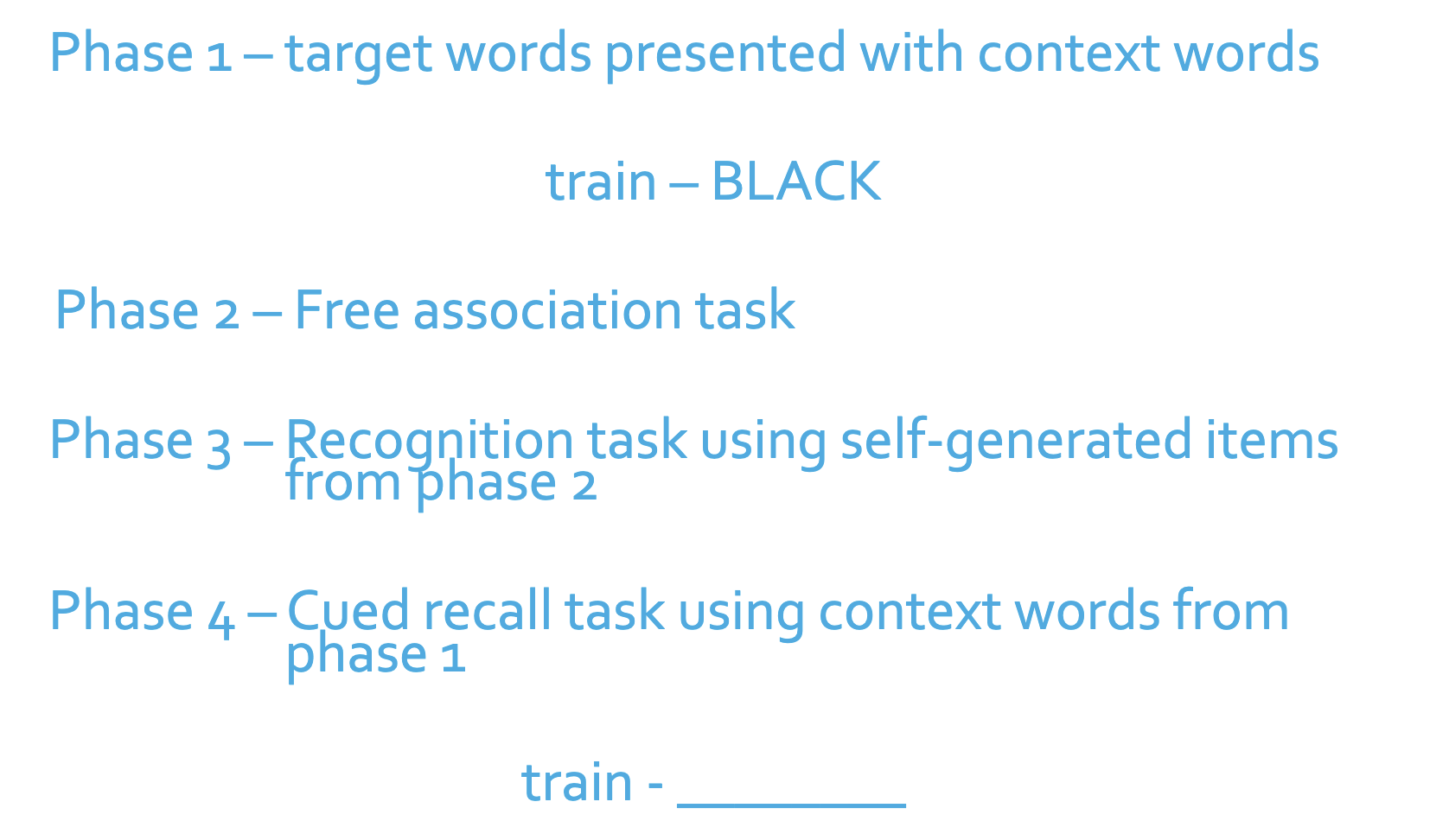
What were the results of Tulving and Thomson’s experiment? How does this provide evidence for the encoding specificity theory?
They found that participants recalled more words than they were able to recognise.
Phase 3: 24% recognition
Phase 4: 63% recall
According to levels of processing theory, since the participants enacted in elaborative rehearsal in phase 2, phase 3 should have a higher percentage than phase 4 where semantic meaning was not used. However, this was clearly not the case!
Thus, providing evidence for the Encoding Specificity Theory.
How can encoding specificity theory be broken down into 3 parts?
transfer appropriate processing (what you need to process something should also be what you need to retrieve it)
context dependent learning (context of encoding must match the with context of retrieval—loud when encoding and loud when retrieving)
state dependent learning (state of encoding must match the with state of retrieval—sober when encoding and sober when retrieving)
Explain an experiment about context-dependent learning.
Godden and Baddeley
Scuba divers learned word lists on land and in the water. Those who learned on land were asked to retrieve the words in the water and vice versa.
When the divers learned the words on land and were asked to retrieve on land their number of words recalled was high. However, when they were asked to retrieve the words in the water they could not recall as many. This was the exact effect for those who learned in the water and were asked to retrieve on land.
Hence, they found that there was a direct cross-over between the contexts of the encoding and retrieval process, supporting context dependent learning.
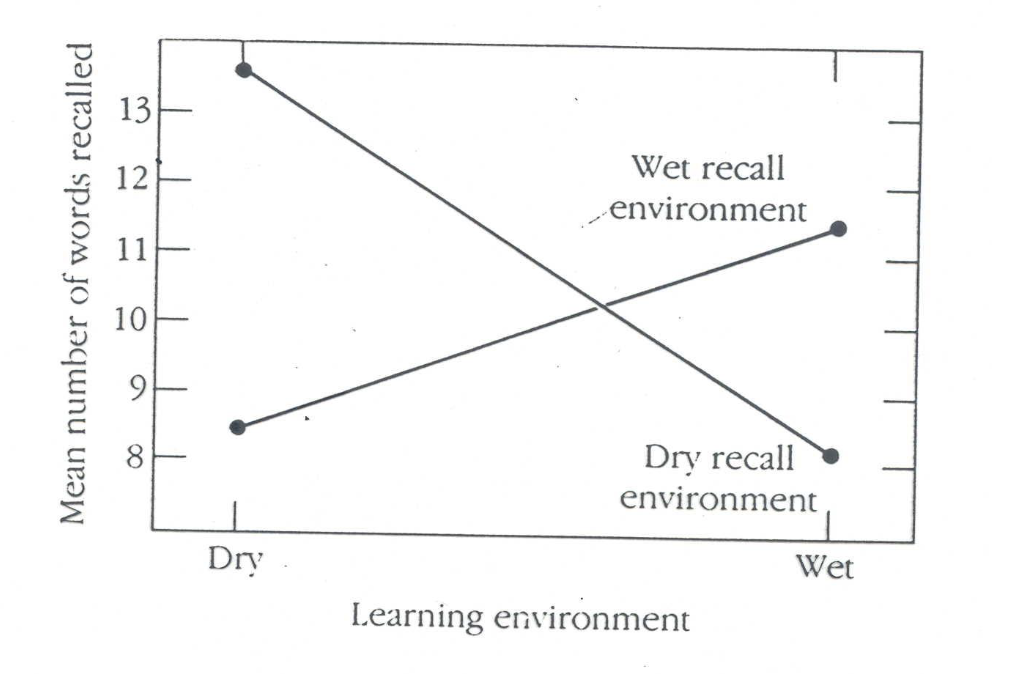
Explain an example about state-dependent learning.
People were wondering if you go to class drunk, should you show up to the exam drunk.
If you are sober at encoding, your retrieval with be better when sober (when you match the state you were in during encoding with retrieval).
Similarly, if you are intoxicated at encoding, your encoding will be better when intoxicated compared to if you were sober (when your state during encoding is different than that during retrieval).
Nonetheless, the main effect was being sober during encoding as encoding is much better when sober vs intoxicated.
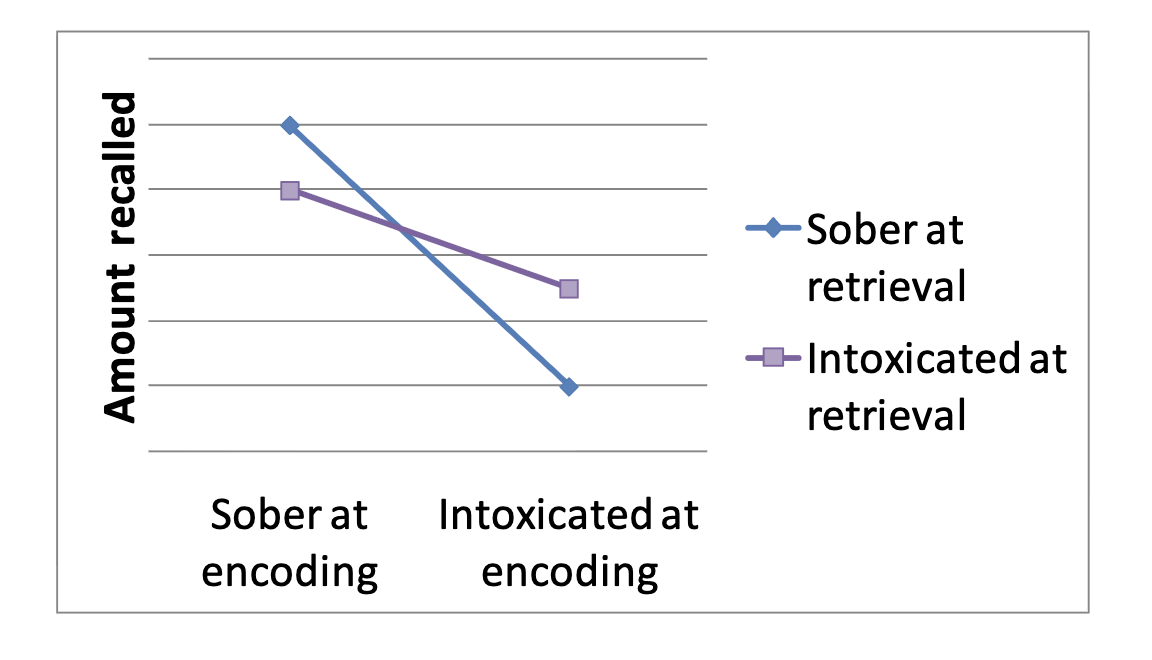
What are ways to improve your LTM?
Engage in deep processing (which is basically to add meaning to meaningless lists)
Organise your thoughts via categories and hierarchies
Make the information personally relevant
Generate the information yourself
Use imagery (Paivio’s dual code theory)
Use interactive images
Explain, with an example, why organising the information into categories improves our LTM.
Bower
He had participants memorise a grocery list of 72 items. There were 2 conditions; one where the items were arranged in a hierarchical order and another where it was all random (but visually it was stacked in a hierarchical order).
The condition that had to hierarchical ordered list was able to memorise the 72 items after 4 trials. But those without any organisation for the lists could barely remember the stuff.
Therefore, this illustrates the impact that organisation can have on our LTM.
Explain, with an example, why making things personal to us improves our LTM?
Rogers et al.
By making the things personally relevant to us, we are making the memory distinct in our minds—which makes it easier to retrieve.
What’s an example of generating to information yourself to improve your LTM?

Explain Paivio’s dual-code theory.
When we use imagery after processing something we hear, we get at least 2 codes of the information in memory (verbal and visual code).
Hence, aiding in our retrieval and improving our LTM.
How does the use of interactive images improve our LTM? What is an example of this?
Similar to making the things personally relevant to us, creating interactive images makes the thing personally distinct to us.
ie. Let’s say you need to remember to buy bread from the grocery store and pick up the new shoes you bought from amazon. To remember this you form an interactive image of the two things (shoes made of loaves of bread being worn).
This makes the memory distinctive as it is likely a memory you have never had before. Therefore, making it easier to retrieve and improving LTM.
Explain the importance of practice for LTM. Use an example.
For both the levels of processing theory and encoding specificity theory, distributed practice is seen as better than mass practice.
This is because you are most likely to engage in elaborative coding due to the different contexts and states you will be learning the things. Therefore, increasing the number of cues that you can use to recall.
ie. if you study for 2 hours at a cafe on monday which is loud and you are alert that day, and then 2 hours on tuesday in your room where it is quiet and you are tired that day. You have engaged in more elaborate coding due to the different contexts and states you studied the material.
Hence, there are more contexts and states in which you can retrieve the material since you encoded the material in more contexts and states.
As a result, retrieval becomes easier and your LTM improves.